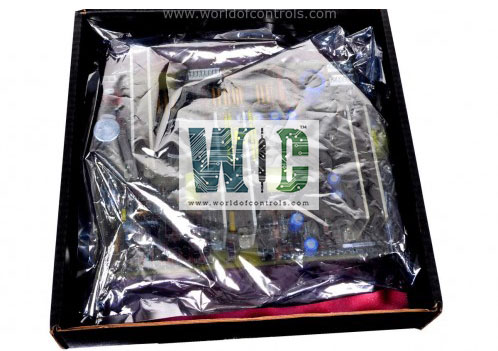SPECIFICATIONS
Part Number: IS200ESYSH3A
Manufacturer: General Electric
Series: EX2100e
Product type: I/O Terminal Board
Control Sections: M1
Group Variation: H3
Manual: GEI-100772
Redundancy: Simplex Control
Connections: PTs and CTs
Number of sub-D pin Connectors: 6
Country of Manufacture: United States (USA)
Functional Description
IS200ESYSH3A is an I/O terminal board developed by GE. The model is a simplex control that is part of General Electric's EX2100e series. Isolation transformers are used in this model. The model has seven auxiliary contact inputs and a 55 VDC power supply. The interface board is used with generator voltage PTs and CTS required for protection functions. The board accepts external I/O and outputs transducers. It is intended to handle all input and output interfacing requirements. PT and CT inputs, general-purpose and trip relay outputs, analog inputs and outputs, and digital control inputs are all included. These interfaces take place via terminal boards mounted on the ESYS board via terminal strips that provide terminal connections. Typically, these daughter boards are HSSL or HSLA boards.
Features
- This board's functional acronym is ESYS, which stands for Excitation Control System I/O Interface. This board's primary function is to connect the basic input and output to the exciter within the control system. The board will handle the majority of the EX2100e system I/O interfaces. The interfaces will be sent to the EX2100e control system via the attached HSLA high-speed serial link (HSSL) daughterboard.
- The model is divided into three groups: H3, H2, and H1, each with its own redundancy mode. Because the model is an H3, it will function as a simplex control.
- Apart from having different redundancy modes and fewer control sections than the other groups, these boards operate in the same way, for example, by supporting excitation contact outputs and inputs. The board can handle CT and PT inputs; there are two generator CT inputs with current ratings of 1 A or 5 A that provide current feedback; and two three-phase generator PT voltage inputs that can be connected together for generator voltage feedback.
- The board has two trip relay outputs, which are typically used to drive a customer lockout device with two-of-three hardware voting outputs. This model can be used in both regulator and static systems, rather than just one of them.
Product Attributes
- The Excitation Control System I/O Interface refers to the Input/Output interface between the control system and the various components and devices in a turbine. The I/O interface enables the control system to receive input signals from various sensors and devices, process the data, and generate output signals to control and regulate the various components in the turbine.
- In a typical turbine excitation control system, the I/O interface includes a combination of analog and digital inputs and outputs, which are used to monitor various parameters such as temperature, pressure, speed, and position, as well as to control actuators and other components in the system. The I/O interface may also include communication interfaces for connecting to remote control systems, data logging systems, and other devices.
- The I/O interface is a critical component of the excitation control system, as it enables the control system to gather data from the various components and devices in the turbine, process this data, and generate appropriate control signals to regulate the turbine's operation. This helps to ensure safe, efficient, and reliable operation of the turbine, while also improving overall performance and availability.
System Features
- This Excitation Control is a cutting-edge control for new and retrofit steam, gas, and hydro generators. To ensure the delivery of a true system solution, the control hardware and software design is closely coordinated between GE's system and controls engineering.
- The EX2100e control, Mark VIe control, Mark VI Integrated Control System (ICS), LS2100e Static Starter, and human-machine interface (HMI) are all seamlessly integrated. Integration with customer distributed control systems (DCS) via ModBus Ethernet is supported for stand-alone retrofit applications.
- The system is available in a variety of configurations to provide full static and regulator control. To meet field current requirements in static applications, Thyristor silicon-controller rectifier (SCR)-based systems use cells with sizes of 42, 53, 77, and 100 mm. PWM systems employ Insulated Gate Bipolar Transistors (IGBTs) to provide up to 35 A or 120 A outputs for Regulator system applications.
EX2100e Overview
The EX2100e control system is available in a variety of configurations to provide full static and regulator control. To meet field current requirements in static applications, Thyristor silicon-controller rectifier (SCR)-based systems use cells with sizes of 42, 53, 77, and 100 mm. PWM systems employ Insulated Gate Bipolar Transistors (IGBTs) to provide up to 35 A or 120 A outputs for Regulator system applications. These systems are capable of supporting the following applications:
- Potential source to 8000 A, static
- Compound source, static
- Regulator system Alterrex
- Saturable Current Transformers/Power Potential Transformer Regulator (SCT/PPT)
- Exciter Regulator with Brushless Motor
- Rotating Exciter Regulator for Direct Current (dc)
WOC is happy to assist you with any of your automation requirements. Please contact us by phone or email for pricing and availability on any parts and repairs.
FREQUENTLY ASKED QUESTIONS
What is IS200ESYSH3A?
It is an Excitation Control System I/O Terminal Board developed by GE
What are the different groups of the ESYS model?
The model is divided into three groups: H3, H2, and H1, each with its own redundancy mode. The H3 group functions as a simplex control.
What are the main functions of the board?
The board supports excitation contact outputs and inputs, can handle CT and PT inputs, and has two trip relay outputs. It provides current and voltage feedback to the control system and can be used in both regulator and static systems.
What are the inputs and outputs supported?
It has two generator CT inputs with current ratings of 1 A or 5 A, two three-phase generator PT voltage inputs, and two trip relay outputs.
